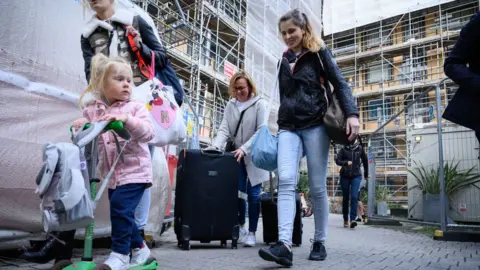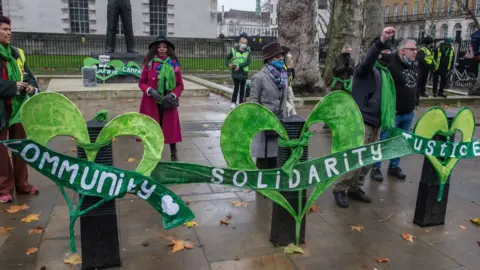Unsafe cladding: What is it and who pays to remove it?
 Getty Images
Getty ImagesSince the Grenfell fire, repairs have been required to buildings with unsafe cladding.
This created an affordability crisis with many flat-owners facing large bills for renovations.
The government has promised to protect residents from "exorbitant" costs and earlier this year the construction industry agreed to pay £5bn to fund repairs.
What happened in the Grenfell fire tragedy?
In June 2017, a fire broke out in the Grenfell Tower block in west London, killing 72 people.
The first phase of an inquiry said cladding installed during refurbishment helped the fire spread because it was made from combustible material.
 Getty Images
Getty ImagesSafety inspections on other high-rise blocks revealed not just dangerous cladding, but other fire safety faults including defective insulation, flammable balconies and missing fire breaks.

Watch Grenfell: Has Anything Changed? on iPlayer.

What is cladding?
Cladding is the process of adding a new layer of material to the outside of a building.
It may be installed to increase insulation or weather protection, or to improve the building's appearance.
But some cladding has been found to be combustible, prompting a building safety crisis affecting thousands of homeowners.
 PA Media
PA MediaWho pays for the repairs?
The cost of making a block of flats safe is supposed to be absorbed by the owners of the whole building and the land (also known as the freeholder).
But in practice the cost has often been passed on to the owners of individual flats (leaseholders).
In January, Housing Secretary Michael Gove promised no leaseholder living in a building more than 11 metres high would face any costs for fixing dangerous cladding.
In April, the government announced that major housing developers would commit a minimum of £2bn to fix any buildings of this size which they had a role in developing.
Mr Gove warned that companies who didn't sign up could face being blocked from building or selling new homes.
The building industry also committed to paying a further £3bn over 10 years through the Building Safety Levy, chargeable on all new residential buildings in England.
This money will be used to fix buildings where those responsible for the cladding could not be identified, or forced to pay.
The End Our Cladding Scandal campaign group says there are still many unanswered questions, including buildings under 11 metres, and that leaseholders are "understandably confused" about their position.
What about other safety measures?
As well as concerns about cladding costs, campaigners say thousands of leaseholders also face large bills to pay for other safety measures not covered by the scheme.
This includes fire breaks, new balconies, safety doors and sprinkler systems.
Mr Gove said it was his intention to offer support for these costs.
How many people are affected?
There isn't a single number on this.
The government says that as of 30 November last year, 407 buildings had cladding removed with a further 70 still with cladding (although work has already started on 41 of these).
But these figures only cover buildings that are over 18m tall, with the type of cladding used on Grenfell Tower.
The government does not supply regular statistics on other types of building.
About half a million people are living in a building with some form of unsafe cladding, the Association of Residential Managing Agents says.
